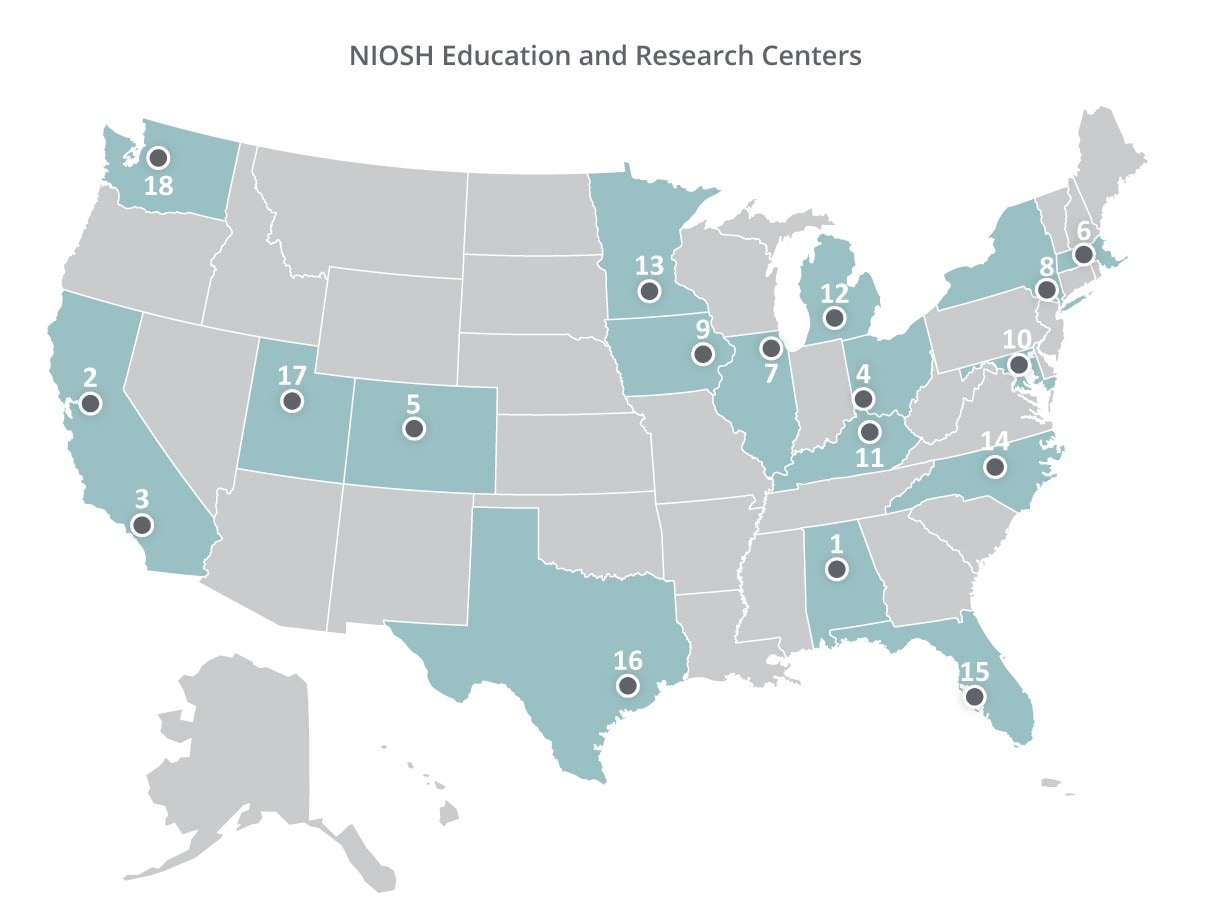Key points
- The 18 Education and Research Centers (ERCs) provide high-quality interdisciplinary graduate and post-graduate training in occupational safety and health disciplines.
- ERC faculty and trainees conduct research to advance occupational safety health.
- ERCs serve as resources for our nation's workforce through continuing education and outreach in their region.

Overview
The Occupational Safety and Health Act of 1970 requires NIOSH to provide an adequate supply of qualified personnel to implement it. The 18 NIOSH Education and Research Centers (ERCs) have a key role in meeting this requirement.
ERCs are academic institutions that provide high-quality training, continuing education, and outreach.
Interdisciplinary graduate and post-graduate training
ERCs focus on the core occupational safety and health disciplines of industrial hygiene, occupational health nursing, occupational medicine, and occupational safety. Allied disciplines are also offered through many of the ERCs. This includes occupational health psychology, Total Worker Health, mining safety, agricultural safety and health, and ergonomics.
Research training
Research and research training are integral components of ERCs. ERC faculty and trainees conduct research on priorities in the National Occupational Research Agenda (NORA) and emerging issues.
Continuing education and outreach
ERCs serve as resources for our nation's workforce through continuing education and outreach in their region. ERCs have strong collaborations with professional associations, worker advocacy groups, businesses, industries, and public health agencies.
Diversity, equity, and inclusion
ERCs enhance diversity, equity and inclusion in the safety and health workforce. ERCs work with Minority Serving Institutions and other NIOSH supported training programs to provide opportunities for students and collaborations.
Impact
Emergency Response
During the COVID-19 pandemic, ERCs responded rapidly to the needs of students, faculty, and staff at their universities. They shared their expertise with businesses and organizations in their region. They provided guidance on proper use and decontamination of personal protective equipment and respirator fit testing. They also advised on social distancing for worksites and the use of physical protective barriers. Many ERCs developed communication products, resource guides, online courses, and webinars on safe work practices during the pandemic.
ERCs continue to train safety and health practitioners and researchers with the knowledge and skills for emergency preparedness and response. Historically, ERCs have provided expertise in worker health and safety following events such as:
- Hurricanes (Katrina, Maria, and Harvey)
- Deepwater Horizon Oil Spill
- Illicit drug exposures to law enforcement and EMS personnel
- Ebola and influenza outbreaks
Future Workforce
NIOSH's network of ERCs is critical in developing professionals prepared to respond to the changing nature of work. New technologies, and the combined pace of automation and globalization, are changing work and workplaces. Employers and workers must navigate issues such as an aging workforce, gender and racial inequalities, and climate change.
The ERCs provide well-trained graduates and professionals who go on to work for:
- Federal, state, and local government agencies
- Non-profit organizations
- Academic institutions
- Industry organizations and businesses
- Healthcare organizations
- Labor organizations
Over 20,000 individuals have graduated from ERCs in the core and allied disciplines of occupational health and safety since 1977.
ERCs

- Deep South Center for Occupational Health and Safety at the University of Alabama at Birmingham
- Northern California ERC at the University of California, Berkeley
- Southern California ERC at the University of California, Los Angeles and University of California, Irvine
- University of Cincinnati ERC at the University of Cincinnati
- Mountain and Plains ERC at University of Colorado Denver
- Harvard T.H. Chan ERC at the Harvard T.H. Chan School of Public Health
- Great Lakes Center for Occupational Health and Safety (Illinois ERC) at University of Illinois at Chicago
- New York and New Jersey ERC at the Ichan Mount Sinai School of Medicine
- Heartland Center for Occupational Health and Safety at the University of Iowa
- Johns Hopkins ERC at the Johns Hopkins School of Public Health
- Central Appalachian Regional ERC at the University of Kentucky
- Center for Occupational Health and Safety Engineering at the University of Michigan
- Midwest Center for Occupational Health and Safety at the University of Minnesota
- North Carolina Occupational Safety and Health Education and Research Center at the University of North Carolina at Chapel Hill
- Sunshine ERC at the University of South Florida
- Southwest Center for Occupational and Environmental Health at the University of Texas Health Science Center at Houston
- Rocky Mountain Center for Occupational and Environmental Health at the University of Utah and Weber State University
- Northwest Center for Occupational Health and Safety at the University of Washington
Funding sources
NIOSH funds ERCs under RFA-OH-25-002. Previously, ERCs were funded under RFA-OH-23-003. New awards are for three years and renewals are for five years.
